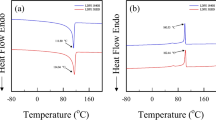Abstract
Fatigue fracture surface characteristics of five commercially available amorphous polymers [poly(methylmethacrylate) (PMMA), polycarbonate (PC), poly(vinyl chloride) (PVC), polystyrene (PS), and polysulphone (PSF)] as well as bulk-polymerized PMMA prepared over a wide range of molecular weights were studied to determine if common mechanisms of fatigue crack propagation prevail among these glassy polymers. In those polymers with viscosity-average molecular weight ¯M v≲2×105, the macroscopic appearance of the fracture surface showed the presence of a highly reflective mirror-like region which formed at low values of stress intensity and high cyclic test frequencies (∼100 Hz). The microscopic appearance of this region revealed that many parallel bands exist oriented perpendicular to the direction of crack growth and that the bands increase in size with ΔK. In all instances, the crack front advanced discontinuously in increments equal to the band width after remaining stationary for hundreds of fatigue cycles. Electron fractographic studies verified the discontinuous nature of crack extension through a craze which developed continuously with the load fluctuations. By equating the band size to the Dugdale plastic zone dimension ahead of the crack, a relatively constant yield strength was inferred which agreed well with reported craze stress values for each material. At higher stress intensity levels in all polymers and all values of ¯M v, another series of parallel bands were observed. These were also oriented perpendicular to the direction of crack growth and likewise increased in size with the range in stress intensity factor, ΔK. Each band corresponded to the incremental advance of the crack during one load cycle, indicating these markings to be classical fatigue striations.
Similar content being viewed by others
References
J. A. Manson and R. W. Hertzberg, CRC Rev. Mac. Sci. 1 (1973) 433.
R. W. Hertzberg, J. A. Manson and M. D. Skibo, Polymer Eng. Sci. 15 (1975) 252.
M. D. Skibo, R. W. Hertzberg and J. A. Manson, J. Mater. Sci. 11 (1976) 479.
R. W. Hertzberg and H. Nordberg, ibid 5 (1970) 521.
R. W. Hertzberg, J. A. Manson and W. L. Wu, ASTM STP 536 (1973) 391.
B. Mukherjee and D. J. Burns, Exp. Mech. 11 (1971) 433.
S. Arad, J. C. Radon and L. E. Culver, Polymer Eng. Sci. 9 (1969) 339.
G. H. Jacoby, ASTM STP 453 (1969) 147.
G. H. Jacoby and C. Cramer, Off. of Nav. Res., A. F. Mat. Lab., Proj. NR064-470 (1967).
M. D. Skibo, unpublished research.
J. P. Elinck, J. C. Bauwens and G. Homes, Int. J. Fract. Mech. 7 (3) (1971) 227.
R. W. Hertzberg and J. A. Manson, J. Mater. Sci. 8 (1973) 1554.
S. Rabinowitz, A. R. Krause and P. Beardmore, ibid 8 (1973) 11.
V. Havlicek and V. Zilvar, J. Macro. Sci. B5 (2) (1971) 317.
A. D. McMaster and D. R. Morrow, Polymer Eng. and Sci. 14 (1974) 801.
G. P. Marshall, L. E. Culver and J. G. Williams, Int. J. Fract. 9 (3) (1973) 295.
B. Rosen, “Fracture Processes in Polymeric Solids” (Interscience, New York, 1964).
J. S. Harris and I. M. Ward, J. Mater. Sci. 8 (1973) 1655.
D. S. Dugdale, J. Mech. Phys. Solids 8 (1960) 100.
N. J. Mills, Eng. Fract. Mech. 6 (1974) 537.
R. D. R. Gales and N. J. Mills, ibid 6 (1974) 93.
H. F. Brinson, Proc. Soc. Exp. Stress Anal. 27 (1970) 93.
M. Creager and P. C. Paris, Int. J. Fract. Mech. 3(4) (1967) 247.
J. Murray and D. Hull, J. Polymer Sci. A-2 8 (1970) 583.
S. Rabinowitz and P. Beardmore, CRC Rev. Mac. Sci. 1 (1972) 1.
J. A. Manson, R. W. Hertzberg, S. L. Kim and M. Skibo, Polymer 16 (1975) 850.
J. F. Fellers and B. F. Kee, J. Appl. Polymer Sci. 18 (1974) 2355.
R. P. Kambour, General Electric Co. Technical Information Series, No. 72CR0285 (1972).
J. P. Berry, J. Polymer Sci. A-2 (1964) 4069.
R. P. Kusy and D. T. Turner, Polymer 17 (1976) 161.
H. H. Kausch, Kunstoffe 65 (8) (1976) 1.
S. C. Kim, M. Skibo, J. A. Manson and R. W. Hertzberg, Polymer Preprints 17 (1) (1976) 144.
S. Wellinghoff and E. Baer, J. Macromol. Sci. Phys. B11 (1976) 367.
S. C. Kim, M. Skibo, J. A. Manson and R. W. Hertzberg, Polymer Preprints 15 (1975) 559.
Author information
Authors and Affiliations
Rights and permissions
About this article
Cite this article
Skibo, M.D., Hertzberg, R.W., Manson, J.A. et al. On the generality of discontinuous fatigue crack growth in glassy polymers. J Mater Sci 12, 531–542 (1977). https://doi.org/10.1007/BF00540278
Received:
Accepted:
Issue Date:
DOI: https://doi.org/10.1007/BF00540278




